A Comprehensive Guide to Starting Jewelry Design
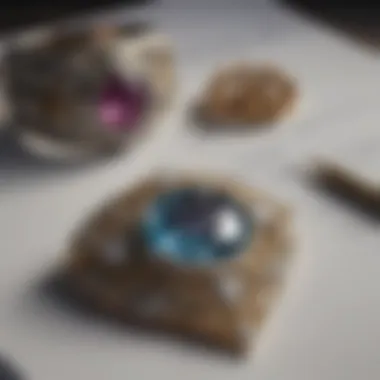
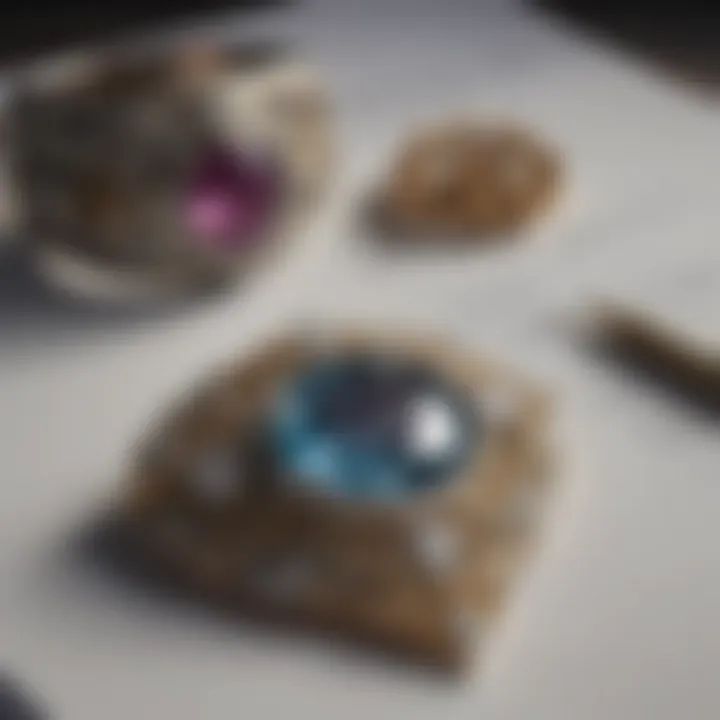
Intro
Entering the world of jewelry design can often feel like stepping into a dazzling realm filled with potential and creativity. For many, the thought of creating pieces that adorn individuals and hold sentimental value sparks a deep curiosity. As the jewelry industry continues to evolve, the demand for skilled designers remains as vibrant as the gems themselves. Whether you are coming from a background in art, fashion, or geology, there are numerous paths you can take to dip your toes into this multifaceted industry.
This article serves as a guiding light for newcomers, illuminating the various entry points into jewelry design. From understanding the intricacies of gemstones to mastering the essential technical skills, we'll cover comprehensive steps to help you embark on this creative journey. Gear up to explore the nuances between metals and stones and how your personal touch can transform ordinary materials into extraordinary masterpieces.
Gemstone Overview
Definition and characteristics
Gemstones are more than just pretty trinkets; they are natural marvels formed over millions of years beneath the Earth's surface. Each stone tells its own story – from the conditions of its formation to the unique factors that contribute to its appeal. A gemstone, in a nutshell, is a precious or semi-precious mineral that has been cut and polished for folks who wear it.
When considering gemstones, some key characteristics come into play:
- Color - This is arguably the most striking feature. It's not just the hue but the intensity and saturation that catch the eye.
- Cut - A well-cut gemstone can reflect and refract light in captivating ways, enhancing its visual appeal.
- Clarity - Refers to the presence of inclusions or blemishes. The fewer the imperfections, the higher the clarity.
- Carat weight - This measures the size of the gemstone. Larger stones are often more desirable, but quality can outweigh size.
Classification of gemstones
Gemstones can be broadly classified into two categories: precious and semi-precious stones. This dichotomy, however, can be somewhat misleading, as the valuation often depends on market demand rather than inherent qualities.
- Precious gemstones include diamonds, rubies, sapphires, and emeralds. These stones typically command higher prices due to their rarity and desirability.
- Semi-precious gemstones encompass a variety of stones including aquamarine, amethyst, and citrine, which while beautiful, may not carry the same market weight as their precious counterparts.
Understanding these classifications is crucial for any aspiring jewelry designer, as it influences both design choices and material selection.
Properties of Gemstones
Physical properties
The physical properties of gemstones play a vital role in their application within jewelry. Some crucial physical attributes include:
- Hardness - Measured on the Mohs scale, hardness determines a stone's resistance to scratching. Diamonds, for instance, top this scale.
- Luster - This describes how light interacts with the surface. A gemstone may have a glassy, dull, or oily luster.
- Transparency - Some stones are transparent, while others may be opaque. This affects how they are used in design, influencing the incorporation of light in pieces.
Chemical properties
The chemical properties, on the other hand, inform us about the stone's makeup. For example:
- Diamonds are primarily composed of carbon, while emeralds feature beryllium, aluminum, and other elements.
- The presence of trace elements often contributes to distinct colors and characteristics, such as iron in sapphires giving them a blue hue.
Understanding these properties is particularly important for learners in jewelry design, as they affect how the materials will behave during creation and the final presentation of your designs. Knowledge of these factors can distinguish a novice designer from a seasoned artisan.
"In jewelry design, knowing your materials is as essential as knowing your audience."
Delving into gemstone properties will enrich your designs, ensuring each piece resonates with its wearer in a significant way.
Understanding Jewelry Design
In the realm of jewelry design, grasping the fundamentals is like having a sturdy lifebuoy while navigating choppy waters. Before diving into creativity, one must lay down the groundwork—fully understanding jewelry design is crucial for any aspiring designer. This section sheds light on the key aspects that shape the foundation of this vibrant field.
Defining Jewelry Design
At its core, jewelry design is not merely about crafting stunning pieces to adorn the body. Instead, it's an intricate blend of art and craftsmanship that marries aesthetic appeal with functional attributes. Trends may rise and fall like tides, but the essence of jewelry design is deeply rooted in personal expression and cultural significance.
Think about it: each piece tells a story, whether it’s a diamond engagement ring symbolizing commitment or a pair of handcrafted earrings reflecting an artist's journey. What separates good design from great design is a keen awareness of materials, techniques, and the emotional resonance they create.
Jewelry design can be broken down into several elements that define its scope:
- Material Selection: The choice between gold, silver, gemstones, and alternative materials influences the final look and feel.
- Craftsmanship: The skill involved in shaping and assembling materials distinguishes designers from mere assemblers.
- Cultural Context: Jewelry often reflects social status, traditions, and personal beliefs. A designer must recognize and respect these aspects.
Grasping these elements arms a designer with the knowledge needed to create meaningful and commercially viable pieces. It’s the first step toward honing a unique design philosophy while aligning with both customer expectations and market demands.
The Role of a Jewelry Designer
The function of a jewelry designer goes beyond the obvious act of creation; it's a multifaceted role filled with challenges and rewards. Designers are curators of ideas, transforming visions into tangible beauty. They begin with sketches that ignite the imagination and evolve these concepts into three-dimensional objects.
Key responsibilities of a jewelry designer include:
- Idea Generation: Constantly brainstorming and conceptualizing new designs, often influenced by fashion trends, personal experiences, and art movements.
- Client Collaboration: Engaging with clients—whether individuals seeking custom pieces or retailers wanting collections. Understanding their vision is paramount.
- Technical Proficiency: Mastering tools and techniques such as CAD software, stone setting, and metalwork is crucial to refining designs.
- Market Awareness: Keeping abreast of industry trends helps a designer remain relevant and competitive.
Ultimately, jewelry designers play a vital role in connecting culture, emotion, and craftsmanship. They must bridge the gap between art and commerce, ensuring that every piece not only appeals to the eye but also satisfies and resonates with the buyer's desires.
"Jewelry can be a powerful expression of identity, culture, and individual taste; it’s not simply an accessory, but an extension of who we are."
Understanding jewelry design therefore is not just about knowing how to make something beautiful; it's about knowing why beauty matters and how it can impact the lives of others.
Educational Pathways
Understanding the landscape of educational pathways in jewelry design is crucial for those looking to carve out a niche in this intricate and creative field. This section emphasizes the different avenues available for aspiring designers, including formal education, workshops, and online courses. These pathways not only hone technical skills but also cultivate a designer’s unique vision and confidence, enabling them to stand out in a competitive marketplace.
Formal Education Options
Formal education in jewelry design provides a structured learning environment where students can deeply delve into both the artistic and technical facets of the craft. Institutions like the Rhode Island School of Design and the Gemological Institute of America offer comprehensive programs. These programs typically cover everything from metalworking to gemstone identification. The benefit here is the rigorous foundation in skills and techniques, often taught by seasoned professionals. However, one must consider the cost and duration of such programs, as they can be a significant investment.
One example of what you might learn includes the use of specific tools, such as torches and saws, as well as knowledge in using CAD (computer-aided design) software, which is becoming increasingly important in the modern jewelry-making process.
Skill Development Through Workshops
Workshops can be a goldmine for emerging jewelry designers. Unlike formal education, workshops often focus on specific skills or techniques over a shorter time frame. Attendees can learn specialized skills such as stone setting or enamel work directly from industry experts. This hands-on experience is invaluable, as it allows participants to touch and feel the materials without the long-term commitment of a degree program.
Furthermore, workshops offer a fantastic opportunity for networking. Meeting others in the same boat can spark collaborations or mentorships that would greatly benefit your design journey. While it’s not as structured as a formal program, such experiences create a community of shared learning and creativity.
"Workshops bridge the gap between theory and practice, allowing designers to find their footing in a dynamic environment".
Online Courses and Resources
In our digital age, online courses have opened up vast opportunities for jewellery design enthusiasts. Platforms like Skillshare and Coursera provide flexibility and a range of subjects — from the basics of design to advanced techniques in 3D modeling. These options empower individuals to learn at their own pace, making it particularly advantageous for those balancing other responsibilities.
Users can often access resources like video tutorials, forums, and critiques from instructors, all while connecting with a global community of learners. This trend is imaging appealing due to the breadth of topics available and their accessibility.
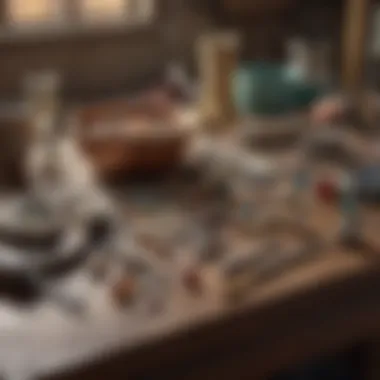
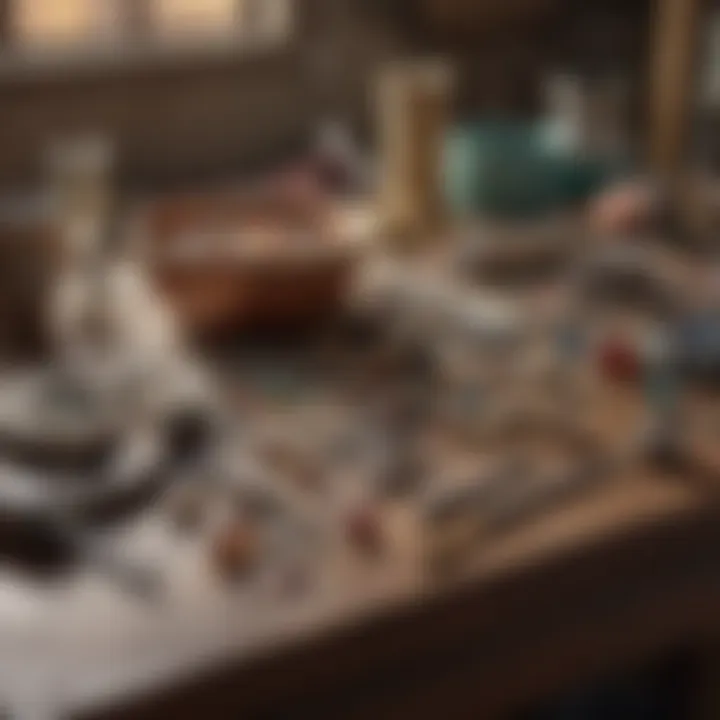
Moreover, websites such as Reddit's jewelry-making subreddits allow enthusiasts to share tips, tutorials, and even personal stories. Not only do they enrich one’s learning experience, but they also build valuable connections in the jewelry design sphere.
Engaging with online resources sets a solid foundation for self-education, making it possible to stay updated on trends and techniques, which is essential in this ever-evolving field.
Essential Skills for Jewelry Design
In the vibrant world of jewelry design, possessing the right skill set is indispensable. Anyone aspiring to create stunning pieces needs to delve into essential skills that form the backbone of good design. Each skill enriches your capability, enabling more profound creations. They don't just shape your creativity but also guide your journey through the field, making your work both eye-catching and technically sound.
Sketching and Conceptualization
Sketching serves as the initial voice of your design. It's where ideas take form, providing clarity before delving into material selection or production. An effective sketch often captures both the essence and intention behind a piece, offering insight not only into visuals but also into functionality.
Having a solid grounding in sketching helps you express thoughts quickly. Whether it's a rough draft on a napkin or a detailed illustration, your sketches communicate your concepts to collaborators and clients. From basic shapes to intricate designs, mastering this art is key. As you sketch, think about proportions, movement, and the relationship between elements. This can transform a mere idea into a desirable product that others can appreciate.
Remember, it's not about being an artist; it’s about clearly conveying your vision. The sketching process can be fluid, accommodating improvisations and new thoughts. This front-end focus sets a strong stage for realizing your creative ambitions.
Materials Knowledge
Knowing your materials inside and out is crucial in jewelry design. Each material has unique properties that dictate how it can be shaped and transformed, influencing everything from durability to aesthetics. It's not simply about choosing metals or stones; understanding their characteristics enhances your design potential.
For example, knowing the difference between sterling silver and fine silver can affect your choice for a particular design and its longevity. Similarly, with gemstones, recognizing the hardness, cleavage, and refractive properties can lead to more informed decisions about durability and settings.
When sourcing materials, consider factors like:
- Sourcing techniques
- Ethical practices
- Visual appeal
Being informed about sustainable sourcing has risen in importance in recent years, with many consumers preferring pieces made from responsibly mined materials. Hence, an acute awareness of materials can set your designs—and ultimately you—apart from the crowd.
Techniques and Tools
The tools and techniques you employ are what bring your sketches and material choices to life. From soldering to stone setting, each technique requires a specific set of tools, mastery over which is integral to the quality of your final product. Investing time in learning these techniques can positively affect both the design process and the outcome.
Key techniques to explore might include:
- Metalsmithing - The art of manipulating metal into desired shapes.
- Lost-wax casting - An innovative process for creating intricate designs.
- Wire working - Useful for creating delicate pieces and embellishments.
This blend of knowledge emphasizes the importance of becoming proficient in using traditional hand tools alongside modern machinery like 3D printers.
"The right tool in the right hands can create wonders; it bridges vision to reality."
By developing a well-rounded skill set in these areas, you not only enhance your creativity but also prepare yourself to meet the demands of the jewelry industry. Embrace the journey of learning as each skill you acquire opens new windows of creativity and expression.
Developing a Personal Style
Crafting a personal style in jewelry design isn't just a matter of preference; it’s the heart and soul of a designer’s identity. It’s about translating personal experiences, cultural backgrounds, and artistic influences into wearable art. Having a distinctive voice sets one apart in a crowded market, nurturing creativity while drawing in a specific audience. The unmistakable thread of originality enhances the allure of your jewelry and solidifies your place in the industry.
Identifying Influences
The journey to sculpting a personal style often begins with the process of identifying influences. Consider the vast range of sources available—from nature’s intricate patterns to historical artifacts or even contemporary art movements. Artists often find that inspiration strikes from unexpected places. Something as simple as the curve of a leaf or the color palette of a sunset can ignite ideas for unique designs.
To effectively identify influences, create a mood board. Gather images, textures, and sketches that resonate with your aesthetic. This practice is particularly useful; it serves as a visual anchor and a continuous source of inspiration. Engage in various forms of art, attend exhibitions, or simply wander through different neighborhoods. Interaction with diverse cultures and lifestyles fosters a broader perspective, enriching the design process.
Creating a Unique Aesthetic
Once you’ve pinpointed your influences, the task turns toward weaving them into a unique aesthetic. This is where personal expression truly shines. For instance, integrating geometric shapes can lend a modern touch, while organic forms may speak to a love for nature. Experimentation plays a crucial role—don’t shy away from combining various materials or techniques. This alchemical approach taps into creativity while producing distinctive pieces.
"Your aesthetic doesn’t just show your skills; it tells your story. Each piece of jewelry is a chapter in your journey."
Consistency is key here. It’s vital to ensure that your aesthetic remains cohesive across all designs. Think of signature elements—maybe it’s a specific stone, a favored color palette, or a particular clasp design. Over time, these will resonate with clients and strengthen brand recognition.
Emphasizing individuality in your designs not only establishes a connection with consumers but also fosters a sense of authenticity. In a world where trends may come and go, a strong personal style remains a lasting tribute to your vision.
Establishing a personal style involves introspection, exploration, and a willingness to embrace experimentation. While the influences may vary, the ultimate aim is to create jewelry that reflects one's unique perspective, making each piece not just an accessory, but a story worn proudly.
Building a Portfolio
Creating a portfolio is crucial for anyone aspiring to thrive in jewelry design. It's not just a collection of your work; rather, it serves as a tangible representation of your creative journey and skills. A thoughtfully curated portfolio can make the difference between landing a client and being overlooked. This document becomes your visual resume, underscoring your unique style and the variety of techniques you've mastered. It’s essential to think of your portfolio as a storytelling device, where each piece speaks volumes about your creativity and vision in the jewelry industry.
Why a Portfolio Matters
A portfolio allows you to showcase your strengths and your design philosophy. When potential clients or employers or even fellow designers glance at your work, they form an opinion almost instantly. The importance of an effective portfolio lies in several key elements:
- First Impressions: The audience often judges your capabilities by your portfolio alone. A well-designed collection of work can excite them right off the bat.
- Diversity in Design: Including a range of styles, materials, and techniques shows your ability to adapt and innovate. This diversity can be a major draw for clients seeking something unique.
- Professionalism: A polished portfolio can give you an edge in the competitive jewelry market. It signals that you take your craft seriously.
- Self-Reflection: The process of putting together a portfolio forces you to evaluate your work and identify your strengths and weaknesses. This can lead to significant growth as a designer.
"The true measure of a designer’s talent is often found in the pieces that didn’t make the cut for the portfolio."
Importance of a Portfolio
The weight of a portfolio cannot be overstated. For starters, it acts as your ambassador in situations where you can’t be there to explain your work. Potential clients or employers could decide your fate based solely on what they see in your portfolio. Furthermore, a solid portfolio also allows you to explore niches within jewelry design that might not have been apparent at the outset. By viewing your work in a collection, you can often identify patterns or themes that inform your future projects.
In addition, a comprehensive portfolio can attract the right audience. If you're targeting luxury gemstone collectors, for example, your portfolio should reflect that specific aesthetic and the quality of craftsmanship they expect.
How to Showcase Your Work
When it comes to showcasing your work, there's no one-size-fits-all approach. A few strategies can enhance your portfolio presentation:
- High-Quality Photography: Invest in professional photography. Good lighting and composition can elevate even simple designs to striking pieces of art. Remember to take pictures from multiple angles.
- Clear Descriptions: Alongside each piece, provide insights into the story behind it, the materials used, and any techniques you mastered while creating it. This contextualization adds richness to the viewer's experience.
- Online and Offline Presence: A digital portfolio can tap into a vast audience through social media platforms or personal websites. In contrast, a physical portfolio is valuable when meeting clients in person. Balance both forms effectively.
- Organization: Showcase your work in a logical sequence. You might group pieces by collections, themes, or materials, which can contribute to a smoother narrative flow.
Ultimately, whether you're just starting or have been in the game for years, building a portfolio is a necessary step. This journey not only represents your work visually but also encapsulates your evolving identity as a jewelry designer.
Navigating the Business Side
The world of jewelry design is not just about creativity; it also has a significant business component. Understanding how to navigate this side is crucial for aspiring designers. Knowing the ins and outs of establishing a business can be as important as mastering the art of designing wearable art. Navigating the Business Side encompasses vital elements like setting up a business structure, understanding market trends, and branding, which can ultimately determine the success of your designs.
Having a solid grasp on business management allows designers to transition from mere creators to successful entrepreneurs. This part of the journey can be daunting, but with proper planning and strategy, it can become a rewarding pursuit.
Setting Up a Business
When stepping into the jewelry industry, the first brick you need to lay is the business foundation. Setting up your business involves several steps. Here’s a run-through of what you should consider:
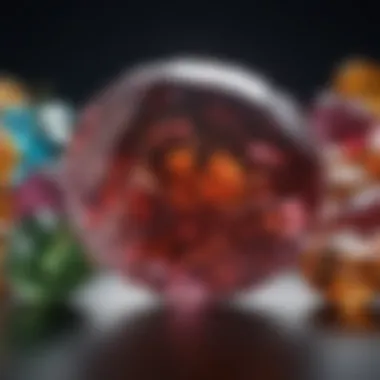
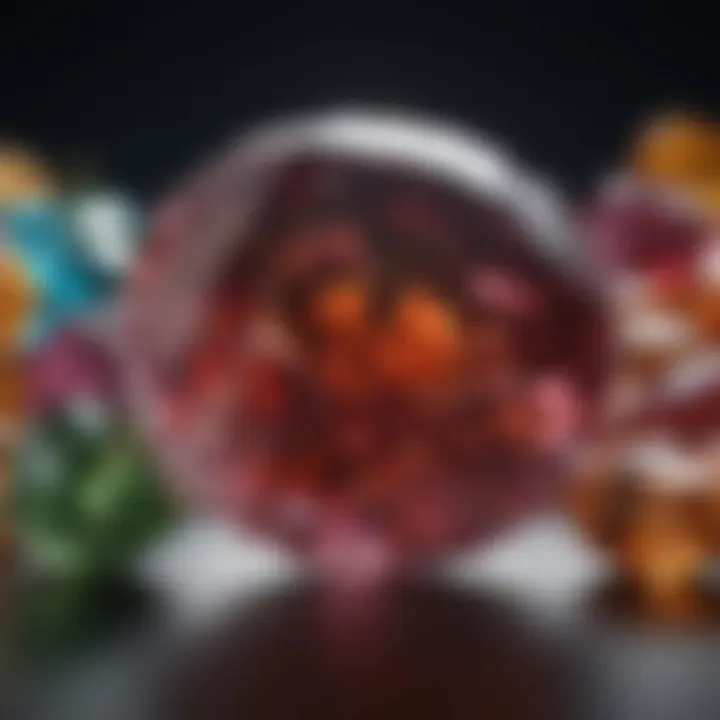
- Business Structure: Decide if you want to register as a sole proprietor, LLC, or corporation. Each has its advantages and disadvantages regarding liability, taxes, and complexity of setup. An LLC, for instance, might shield your personal assets but may require more paperwork and fees.
- Licenses and Permits: Depending on your location, you may need various permits to conduct business, especially if you’re selling precious metals or gemstones that could have distinct regulations.
- Financial Setup: Open a business bank account to separate your personal and business finances. This not only helps streamline your accounting but also gives your business a professional image. Consider also working with an accountant who understands the specifics of the jewelry industry.
"The real value of setting up a solid business framework is protecting yourself and your creative output from unforeseen risks."
Don’t forget about drawing up a business plan. This plan should describe your business goals, the target market, financing, and marketing strategies. This blueprint will serve as your guiding light while navigating the often rocky terrain of the jewelry market.
Marketing Your Designs
Once your business structure is established, the next step centers on marketing your designs. Effective marketing is what turns a mere idea into a thriving jewelry line. Here’s how you can make a name for your creations:
- Define Your Brand: Your brand is more than just your logo; it includes your values, mission, and vision. Identify what makes your designs unique and let this shine through your marketing efforts. Think about how you want your customers to perceive your brand.
- Utilize Social Media: Platforms like Instagram and Pinterest are particularly effective for jewelry marketing. Sharing high-quality images of your designs allows potential customers to connect visually with your work. Don’t just post pieces; tell the story behind the designs, showcasing the craftsmanship.
- Networking: Attend jewelry fairs and exhibitions. These events are perfect for meeting fellow designers, potential clients, and suppliers. Building relationships in this space can open many doors.
- Build a Website: A professional website acts as a digital storefront. Ensure it is visually appealing and user-friendly. Include an online shop if applicable, and provide clear information about your pieces, your design process, and how to contact you.
- Customer Engagement: Offer a newsletter or blog to keep your audience informed about new designs, special promotions, or behind-the-scenes looks at your creative process. Engaging with customers fosters loyalty and repeat business.
Finding Your Target Market
Understanding your target market is akin to finding a hidden gem in a cluttered jewelry box; it’s that specific focus that illuminates your path to success in the intricate world of jewelry design. Knowing whom you are designing for directly influences not only your creative process but also the viability of your designs in the marketplace.
Identifying your target audience is crucial in several key areas:
- Product Design: Tailoring jewelry pieces to meet the tastes and preferences of a specific demographic can lead to increased sales. For instance, if your designs lean toward vintage styles, targeting an audience that has an appreciation for retro aesthetics makes sense.
- Marketing Strategies: When you possess a clear image of your ideal customer, your marketing efforts can hit the mark more effectively. You’ll choose marketing channels that resonate with your target demographic, whether it be social media, local art shows, or trade fairs.
- Brand Identity: A strong understanding of your market will help in establishing a brand identity that is both authentic and appealing. For instance, if your primary market is eco-conscious consumers, committing to sustainable materials can reinforce your brand's ethos.
Focusing on these elements not only positions you as a designer who understands the market nuances but also as someone who respects and caters to consumer preferences.
Understanding Consumer Preferences
In the jewelry industry, consumer preferences can shift like the sands of time; therefore, it’s vital to stay attuned. By understanding what drives buyer decisions, you can shape your designs and messaging to resonate deeply with your audience.
Several factors influence consumer choices:
- Style Trends: Jewelry styles often go through phases—what's in vogue might change with the seasons or cultural shifts. Keeping an eye on popular trends can help you adapt your designs accordingly.
- Materials and Sustainability: More buyers gravitate towards items made from ethically sourced materials. Understanding this can lead you to explore sustainable practices in your design process.
- Cultural Influences: Events, holidays, and regional cultures can affect what consumers are looking for. For example, during wedding season, bridal jewelry tends to soar in demand.
To dig deeper into these preferences, consider conducting surveys or engaging with your audience on social media. The feedback you receive could be the goldmine of insights you need.
Engaging with the Jewelry Community
As you navigate your journey in jewelry design, the importance of linking with the jewelry community cannot be overstated. This network can serve as both a support system and a source of opportunity.
Participation in community events, such as exhibitions or craft fairs, allows you to showcase your work and gain firsthand insights from potential customers. Additionally, creating or joining online platforms, such as forums or social media groups dedicated to jewelry enthusiasts, can help you stay informed about industry trends and practices. Here are a few ways to engage:
- Networking Events: Attend or participate in local jewelry shows where designers, vendors, and customers converge. This can lead to valuable collaborations and mentorship opportunities.
- Join Online Platforms: Engaging on platforms like Reddit or Facebook groups can facilitate connections. Discussions can reveal what others in the community value and desire—the perfect insight for a designer.
- Workshops and Classes: Collaborate with fellow designers or join workshops to not only enhance your skills but also to forge friendships and partnerships that may prove essential in your career.
Engagement with the community fosters relationships which can lead to spreading the word about your work, and ultimately, create a loyal customer base. As they say, it’s not just about what you know but who you know.
"Your network is your net worth."
In summary, the journey toward establishing yourself in the jewelry industry is multifaceted, with understanding your target market being a cornerstone of your success. By grasping consumer preferences and actively engaging with the community, you can sharpen your focus and enhance the impact of your designs, paving a clearer and brighter path in jewelry design.
Sustainability in Jewelry Design
Sustainability is not just a buzzword; it’s a necessity in the ever-evolving world of jewelry design. As more designers and consumers become conscious of environmental and ethical issues, understanding the principles of sustainable practices in jewelry can not only enhance a designer's reputation but also attract a conscientious clientele. The jewelry industry has historically been criticized for its impact on ecosystems, human rights, and labor practices. Therefore, addressing sustainability is vital in fostering a healthier future for the craft and market alike.
Ethical Sourcing of Materials
When it comes to creating a sustainable jewelry piece, the sourcing of materials stands as a cornerstone. Ethical sourcing involves ensuring that the materials—like metals, gemstones, and any synthetic alternatives—are obtained responsibly. This means avoiding suppliers who exploit labor or harm the environment. Mining practices can devastate local communities, and turning a blind eye to these issues is no longer feasible or acceptable.
For instance, responsibly sourced diamonds are gaining traction among consumers. These diamonds are confirmed to come from mines that uphold ethical labor practices and environmental stewardship. Designers can look to sources such as the Kimberley Process, which aims to prevent the trade of conflict diamonds, or opt for alternatives like lab-grown diamonds. This approach not only alleviates ethical concerns but can also spur innovation in design, as the growing field of synthetic gems allows for the exploration of unique aesthetics.
Incorporating recycled materials into a design is another effective strategy. This concept isn’t just about reusing silver or gold; it can extend to incorporating vintage gemstones or reclaiming materials from existing jewelry. By choosing to create jewelry from older pieces, designers contribute to reducing waste while ensuring their creations hold historical significance and character.
Eco-Friendly Practices
Sustainable jewelry design doesn’t stop at sourcing; it includes the entire production process. Eco-friendly practices encompass minimizing waste, using energy-efficient techniques, and opting for non-toxic materials. A designer could start with inviting the zero-waste philosophy into their workshop. This could involve repurposing scrap metal or leftover gemstones during the design process. Here are some practical practices:
- Waste Management: Implement recycling systems to deal with metal scraps and excess materials.
- Sustainable Packaging: Use biodegradable or recycled materials for packaging rather than plastic.
- Solar or Wind Power: If a designer has the resources, utilizing renewable energy for production can significantly lower the carbon footprint.
Additionally, the use of eco-friendly finishes or non-toxic adhesives can reduce harmful substances entering the environment. Many contemporary designers are creating pieces with natural pigments or recycled materials, making their work not just beautiful, but also kind to the planet.
"In the jewelry industry, sustainability is not merely an option; it’s the innovative path forward that honors the earth, its resources, and the people who make our adornments happen."
In summary, sustainability in jewelry design is about weaving together ethics, creativity, and functionality. By selecting responsibly sourced materials and adopting eco-friendly practices, designers can set themselves apart in a market that increasingly rewards transparency and conscious choices. As this trend shifts more into focus, the jewelry of the future won’t just sparkle; it will also shine a light on what truly matters.
The Influence of Technology
In the contemporary landscape of jewelry design, technology emerges as a pivotal force, shaping not only the creative possibilities but also the practicality of the craft. Technology in this field isn’t merely a tool but serves as an enabler, allowing designers to stretch their imaginations while streamlining processes that were once cumbersome. Without a doubt, the integration of advanced software and techniques has transformed traditional practices into multifaceted approaches that accommodate both artistry and functionality.
CAD and 3D Printing
The advent of Computer-Aided Design (CAD) coupled with 3D printing marks a significant turning point in how jewelry is designed and produced.
- Precision: CAD software enables artists to create intricate designs with impressive accuracy. Instead of relying on manual methods, which can sometimes yield uneven results, CAD allows for geometric perfection and increased creativity.
- Rapid Prototyping: 3D printing offers the ability to produce prototypes quickly and efficiently, allowing designers to test their ideas before casting. This means less waste in terms of materials and resources. For example, you could print a ring in wax, examine its look and feel, and make adjustments before committing to metal.
- Complexity: The technology allows for designs that are far more complex than hand-crafted pieces. These innovations lead to unique creations that were not possible to produce in the past. Think of structures that mimic organic forms or intricate lattice designs—options that don’t just push boundaries but redefine them.
As an illustration, consider a designer who utilizes CAD to create a gemstone pendant with a significantly detailed pattern. The transition from a digital blueprint to a tangible, wearable piece becomes seamless, thanks to both CAD and 3D printing.
Emerging Trends in Jewelry Tech
The jewelry sector doesn’t just sit back and watch; it's an ever-evolving domain where new trends emerge on a regular basis. Below are just a few exciting directions that show how technology is reshaping jewelry design:
- Wearable Technology: Smart jewelry has gained traction. Pieces like rings that can monitor health stats or necklaces that double as activity trackers are changing the landscape. This fusion of fashion and tech is alluring to a younger demographic that craves functionality without sacrificing style.
- Augmented Reality (AR): Designers are now utilizing AR to enhance the shopping experience. Customers can try on pieces virtually, interacting with designs before they make a purchase. This ability profoundly impacts consumer engagement and satisfaction, leading to a more tailored shopping experience.
- Sustainability Tech: With an increasing awareness around sustainability, new tech solutions emerge every day. For example, lab-grown diamonds and ethically sourced materials powered by extensive data analysis are making it possible for jewelry designers to adhere to eco-friendly practices while catering to an ethical audience.
"The future of jewelry will be defined by technology's ability to fuse creativity with functionality, paving the way for a new age of personalized adornment."
In summary, embracing technology is no longer optional but essential for jewelry designers. With the tools continuing to evolve, there lies an opportunity for designers to transform not just their workflow but also their entire conceptual framework. This shift not only benefits the designers involved but adds a fresh layer for the consumer, creating a dynamic interplay between innovation and personal expression.
Networking and Mentorship
In the world of jewelry design, the connections you forge can be as valuable as the gems you work with. Networking and mentorship play pivotal roles in shaping a designer’s journey. It's not just about having a slick portfolio; it's also about who you know and the relationships you build along the way.
One of the most significant aspects of networking is the opportunity to meet like-minded individuals. These connections can lead to collaborative projects, innovative ideas, and finding a community that understands the challenges and joys of jewelry design. Engaging with others can also open doors, leading to potential clients, partnerships, or insights that wouldn’t be available in isolation.
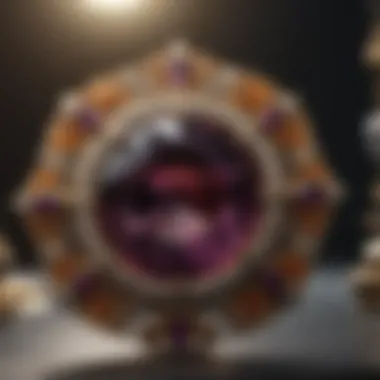
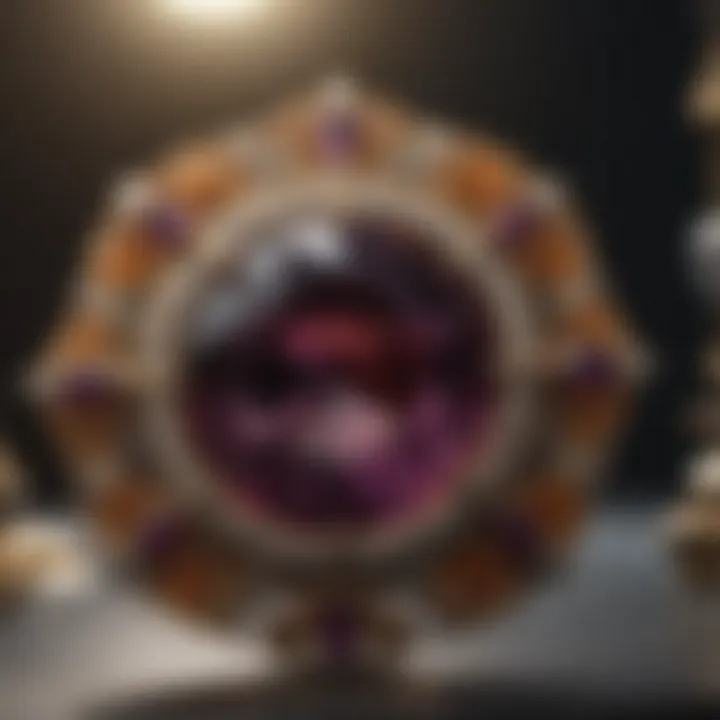
Likewise, mentorship offers invaluable benefits. A mentor who has navigated the same waters can provide guidance on pitfalls to avoid, ideas for improvement, and moral support during tough phases. They can offer perspectives that only experience can bring, which can be a game-changer in an industry where trends change faster than you can sketch them out.
"A true mentor doesn’t just teach; they light the path forward."
Finding Mentors in the Field
Identifying a mentor can sometimes feel like hunting for a needle in a haystack. Start by pinpointing individuals whose work resonates with you. Look into established designers, educators, or even critics who have had a positive impact on the community. Social media platforms like Instagram and LinkedIn can serve as great tools for this.
Once you've found potential mentors, reaching out can be intimidating, but don’t let that hold you back. An effective approach is:
- Introduce Yourself: Share who you are and what you admire about their work.
- Be Genuine: Authenticity goes a long way. A simple compliment along with a specific inquiry can make your message stand out.
- Establish Common Ground: If there are events, courses, or communities you share, mention them. This could build rapport right away.
- Ask Open-Ended Questions: Engage with them through queries that invite a discussion rather than a yes/no answer.
Building Professional Relationships
Once you find mentors, the next step is nurturing those professional relationships. Building a network isn’t about quantity; it’s about quality. It involves consistent effort and a genuine interest in the lives and works of the people within your circle.
Here are some effective strategies:
- Attend Industry Events: Craft fairs, exhibitions, and trade shows are excellent venues to meet people. Join workshops or panels to get up close and personal with the community.
- Stay in Touch: Regularly check in with your contacts through messages or emails. Share updates about your work and inquire about theirs. It shows you care and remember them.
- Collaborate on Projects: If the opportunity arises, suggest working together on a project. This not only strengthens your bond but can also lead to new pathways and insights.
- Offer Value: Networking should be reciprocal. Share resources, knowledge, or insights with your connections. It can be something as simple as an interesting article or a tip about a new tool or technique you’ve discovered.
- Be Respectful of Their Time: While most mentors and connections are willing to share their wisdom, it's important to recognize their time is valuable. Keep interactions concise and meaningful.
Incorporating these elements into your practice will cement your place in the jewelry design community, ensuring that you not only appreciate the craftsmanship of your work but also the people and connections that elevate the entire industry.
Challenges in Jewelry Design
Navigating the landscape of jewelry design isn't a walk in the park. For many aspiring designers, the hurdles can feel overwhelming at times. However, recognizing these challenges upfront can help in formulating strategies to tackle them efficiently. Addressing obstacles has a dual purpose: it equips designers with realistic expectations and deepens their understanding of the industry. This section sheds light on critical elements that every jewelry designer should consider, while also illustrating the benefits that arise from confronting these challenges head-on.
Common Pitfalls to Avoid
Every craft has its share of pitfalls, and jewelry design is no different. Here are some common mistakes that can trip designers up:
- Ignoring Market Trends: While staying true to one’s unique style is important, being blind to market trends can lead to missed opportunities. Designers should periodically familiarize themselves with current preferences and what consumers are gravitating towards.
- Underestimating Cost: Many designers fail to budget properly for materials, tools, or marketing. It’s crucial to have a clear financial plan, so unexpected costs do not derail a project.
- Skimping on Quality: Quality is king when it comes to jewelry design. Cutting corners to save money can result in pieces that don’t meet customer expectations, and it can tarnish a designer's reputation.
- Neglecting Feedback: It’s easy to become attached to one’s creations, but ignoring feedback from peers or clients can stifle growth. Constructive criticism is a gift that can lead to refinement and improvement.
- Failing to Network: Jewelry design isn’t just about having artistic flair; it’s also about using connections. Neglecting to build a network can hinder opportunities for collaboration or exposure.
Designers who sidestep these pitfalls are more likely to find success and satisfaction in their craft.
Managing Client Expectations
Managing client expectations is another crucial challenge that jewelry designers often face. This facet of the process can be tricky but vital for maintaining a good relationship. Here are key considerations:
- Clear Communication: Right from the first meeting, establishing open lines of communication is essential. Discuss timelines, budgets, and design visions explicitly.
- Setting Realistic Timelines: Clients may have their hearts set on speedy deliveries. However, it’s important for designers to communicate what is realistically achievable without sacrificing quality.
- Educating Clients: Many clients may not understand the intricacies involved in the design and creation process. Taking the time to educate them about what goes into making jewelry can cultivate patience and appreciation for the craft.
- Document Everything: Keeping written records of agreements, changes, and communications helps in managing expectations and protecting both parties.
- Be Prepared for Changes: Clients sometimes have visions that evolve over time. Being flexible and willing to adapt can prevent frustration on both sides.
Implementing these strategies can alleviate tensions and pave the way for successful, fulfilling collaborations in the jewelry design field.
"Understanding and addressing difficulties not only helps designers navigate challenges but also aids in developing a resilient, unique approach to their work."
In summation, challenges like common pitfalls and client expectations are integral to the growth of every jewelry designer. Facing these elements with a proactive mindset can lead to richer experiences and ultimately, deeper satisfaction in one's creative journey.
Creating a Brand Identity
Creating a brand identity in jewelry design is not just about slapping on a logo or picking a fancy font; it’s a whole atmosphere that sets you apart. Your brand is a reflection of who you are and what you stand for, and it resonates with your audience on a deeper level. In this industry, where every piece of jewelry tells a story, the identity behind it becomes crucial in building a connection with your customers.
A strong brand identity not only shapes perception but also cultivates customer loyalty. When consumers know what your brand represents, they are more likely to choose your creations over others. Consider how iconic brands like Tiffany & Co. or Cartier have positioned themselves. Their brand elements create a sense of luxury and exclusivity that resonates even with individuals who might not typically purchase high-end jewelry.
Elements of a Strong Brand
When thinking about building your brand identity, consider these core elements:
- Logo and Visual Identity: This includes your logo, color palette, and design aesthetics. Having a cohesive visual identity makes your brand recognizable. A unique logo might incorporate natural elements or gemstones that reflect your designs.
- Brand Name: The name carries weight and is often the first impression. You might want to pick something memorable, easy to pronounce, and reflective of your style.
- Brand Story: Crafting a compelling narrative about why you started designing jewelry can create a deeper bond with your audience. Share your journey, the inspiration behind your designs, and your passion for the craft.
- Target Audience: Understanding who your customer is can tailor your brand messaging and creation process. Consider demographics like age, lifestyle, and values. Are your designs for the environmentally conscious or for those who appreciate classic elegance?
- Core Values: What principles guide your work? Ethical sourcing, sustainability, and creativity could be central to your brand identity. Make sure these values come across clearly in your marketing.
Marketing Your Brand
Once your identity is firm, it’s time to shout it from the rooftops! Effective marketing strategies can bridge the gap between your creations and potential customers. Here’s how to go about it:
- Social Media Presence: Platforms like Instagram and Pinterest are gold mines for jewelry designers. Show off your pieces, share behind-the-scenes looks at your design process, or offer tutorials on styling jewelry.
- Website Development: Your website should be an extension of your brand identity. It needs to be visually stunning, easy to navigate, and optimized for mobile devices. It’s also a place to tell your brand story.
- Networking: Attend art shows, craft fairs, and industry conferences. Building personal connections in these spaces can broaden your reach.
- Collaborations: Teaming up with influencers or other brands can increase visibility. A popular fashion blogger showcasing your pieces can create significant traction online.
- Online Marketplaces: Consider platforms like Etsy or eBay to reach a wider audience. These platforms can help introduce your work to individuals specifically searching for handmade or unique pieces.
"Your brand is what people say about you when you're not in the room." – Jeff Bezos
Achieving a strong brand identity is a stepping stone toward success in jewelry design. This process requires thoughtful planning, consistent messaging, and perhaps a bit of creativity. Ultimately, when you hone in on the elements that define you, you’ll resonate with your audience on a personal level.
The Future of Jewelry Design
The realm of jewelry design isn't just tethered to rich history and tradition; it's a living, breathing entity that evolves with time and technology. Understanding the future of jewelry design is crucial for several reasons. It not only reveals where the industry is headed but also shapes how aspiring designers can enter and thrive within this dynamic environment. Today, sustainability, technological integration, and shifting consumer preferences are not mere trends but pivotal elements influencing the very fabric of jewelry design.
Trends to Watch
Keeping an eye on emerging trends can be the difference between being a leader or a follower in the jewelry industry. Some noteworthy trends that are on the rise include:
- Sustainable Practices: Eco-conscious consumers are making choices that prioritize ethical sourcing and eco-friendly materials. Designers incorporating recycled metals or lab-grown stones stand to gain a significant market advantage.
- Personalization: The age of customization is in full swing. Customers seek jewelry pieces that speak to their individual stories. This includes bespoke designs or engraving options, allowing consumers to add their personal touch.
- Minimalism: Contrasting the opulence often seen in traditional jewelry, minimalistic designs have garnered popularity. Clean lines and simple forms are favored, often appealing to a younger demographic that values subtle sophistication.
- Gender-neutral Jewelry: The lines defining gender in jewelry continue to blur. Designs are increasingly moving towards pieces that anyone can wear, breaking free from traditional gender norms.
"Keeping up with trends isn't just about staying current; it's also about anticipating the future needs and desires of your audience."
Innovations in Design
Innovation in design isn't simply about new styles; it encompasses how these designs are created, marketed, and perceived.
- 3D Printing: One of the most remarkable innovations transforming jewelry design is 3D printing technology. This allows designers to create intricate designs that may have once been deemed impossible, offering an unprecedented level of customization and efficiency.
- Augmented Reality (AR): Many retailers are now employing AR to let customers try on jewelry virtually. Imagine choosing a significant piece without ever needing to step foot in a store. This not only enhances the shopping experience but also widens a designer's customer base.
- Smart Jewelry: The intersection of technology and jewelry is becoming increasingly pronounced, with smart wearable designs that cater to health, connectivity, and more. From fitness trackers designed to look chic to rings that send alerts from devices, the potential for innovation is vast.
Just as technology changes, so too must the designers adapt and innovate. The future of jewelry design is not just about creating beautiful pieces, but understanding what they mean in the context of modern living.
Culmination
In delving into the various dimensions of entry points in jewelry design, we find that this journey is both enriching and multifaceted. The essence of jewelry design isn't solely bound within the realm of creativity; it encompasses a delicate dance between imaginative exploration and practical application. For those considering a foray into this vibrant field, recognizing this duality is crucial.
Reflecting on the Journey
As you reflect on your individual journey in jewelry design, it’s important to appreciate the layers that contribute to your growth. The first step often feels overwhelming—it’s like standing at the base of a mountain, gazing up at the summit. Each aspect of learning, from the foundational skills to the nuances of personal style, adds to your understanding and expertise. Here are some elements to consider as you look back:
- Skill Building: Whether through formal education, workshops, or self-study, each opportunity to hone your skills adds weight to your journey.
- Networking: Building connections isn’t just beneficial; it’s essential. Engaging with fellow designers, mentors, and clients can open doors that are otherwise closed.
- Personal Growth: Every misstep along the way—whether it’s a technical mistake or a misjudged design—teaches invaluable lessons. Each failure is a stepping stone toward mastery.
Reflecting on little victories and important lessons provides a richer context to your experiences. The ability to navigate through challenges will sharpen your intuition and shape your design vision over time.
"Every jewelry designer has a unique story, imbued with moments of inspiration and obstacles overcome. Your story is worth telling."
This amalgamation of experiences not only contributes to technical prowess but also evolves into a personal narrative that defines your brand identity. The future beckons continuously with new trends and technologies, ensuring the landscape of jewelry design remains dynamic. By embracing both victories and setbacks, you set a foundation for your artistic endeavors that is as meaningful as the pieces you create. Your reflection is more than a simple recall; it’s an insightful examination of what it means to be part of this intricate world.
Ultimately, the journey in jewelry design is an opportunity for continuous discovery. Every piece crafted is a reflection of the artist's journey, rich with story and artistry.



